
Mathematician,
astronomer, kalam scholar (B. ? –D. June 9th, 1303 ?). His full name
was Şemseddin Muhammed b. Eşref el-Hüseynî el-Semerkandî and his father’s name
was Eşref. Semerkandî, about whom there isn’t sufficient information
was an intellectual and a scholar, who has many works, in the 13th
century Turkish-Islamic civilization. He created works in the fields of Kalam
(discipline of seeking theological principles through reason), logic,
philosophy, mathematics and astronomy and his works were taught as textbooks in
madrasahs in the following periods of the Islamic world.
After
having been educated in basic sciences, Şemseddin Semerkandî specialized in
kalam, logic and geometry. His works in this field surrounds the preceding
Greek-Helen and Islamic knowledge and also involves his unique and elaborate
contributions in terms of content and discourse. One of the most important
qualities of his works is that they have a concept of universe that is based on
geometrical forms. In this context, he may be seen as the founder of a movement
that can be called “hendesî kalam” in Islamic
world.
In
his theoretical geometry work called “Eşkâl
el-Tesis”, Şemseddin Semerkandî organized thirty five forms from
Euclid’s “Elements”, which was
translated to Islamic world under the name “Usul
el-Hendese”, in a different way. First thirty forms are about geometry and
the last five forms are about algebra. The scholar, who supported Euclid in the
fifth postulate problem (undefined proposition), found the criticisms in Islamic
civilization about this issue invalid. As it is understood from the name of the
work, the most important feature of the work is that it analyzes the basic
geometrical forms, which are thought to represent the realm of existence. In
this context, the work was prepared as an introduction to concept of existence
(ontology), i.e. Platonist philosophy as it is known in the Islamic world. This
work and its commentary “Tuhfet el-Reîs
fî Şerh Eşkâl el-Tesîs”, which was written by Musa Kadızâde in 1412 and
was dedicated to Uluğ Bey, and many explanations (postscripts) written on this
commentary were taught in the Islamic world in madrasahs for long years as a
“medium level” geometry book. This work, which involved different geometrical
approaches that were developed by the Islamic civilization, together with its
commentary determined the intermediate basic geometrical formation of Islamic scholars
for centuries. Şemseddin Semerkandî, who applied the framework he set
by “Eşkâl el-Tesis” to kalam in his
work “el-Sehâif el-İlahiyye”, wrote
the commentary of this work himself and named it “el-Meârif fi Şerh el-Sehâif”. Both of these works were taught at
madrasahs in Islamic world.
Şemseddin
Semerkandî especially focused on logic that was represented by the Aristotelian
philosophy in his own era. His work “Kıstas el-Efkâr fi Tahkik el-Esrâr”
follows the path of logic, which was built by Farabî and İbn
Sina and
was enriched by Gazalî and Fahruddin Razî. This work,
which is considered as an advanced level textbook, also includes the author’s
opinions on himself. A work called “Ayn
el-Nazar fi el-Mantık” in the field of logic is also attributed to him. He
included matters about logic in his works “Şerh
el-Fusûs el-Burhaniyye fi İlm el-Cedel”, which he wrote on Burhanuddin
el-Nesefi’s work in 1287 while he was in Mardin, and “el-Munyet”, “el-Amel fi İlm
el-Cedel”, “Risale fi Adab el-Bahs”
and “el-Munazara” although they were
in the field of ilm-i cedel (scientific
discussion) and ilm-i adab (scientific derivation of hadith). Especially the
last work, which is known under the name “Kitab
Adab el-Bahs”, is accepted as the best work in its field. Dozens of
commentaries and postscripts were written on this work and it was taught at
madrasahs for over five hundred years and is still taught.
Şemseddin
Semerkandî, who set out from the results of researches on logic with his
geometrical approach, wrote a commentary called “Beşâret el-İşârât” on Avicenna’s work called “el-İşârât ve el-Tenbihât”, which involved Avicenna’s late period
philosophy in logic, physics and metaphysics and which had and still maintains
an influence in the history of Islamic thinking. Şemseddin Semerkandî, who sharply
criticized Avicenna from his own point of view in this work, put forth his own
opinions regarding various fields of philosophy in his work.
Şemseddin
Semerkandî also wrote a commentary on a work, which was translated into Arabic
as “el-Macesti” by Ptolemy and was
later rewritten by Nasiruddin Tusî, in the field of theoretical
astronomy. Furthermore, he wrote a general work called “el-Tezkire fi İlm el-Hey’e” about astronomy. In his work “Amel el-Takvim Kevakib el-Sabite” he
prepared a star catalogue belonging to the year 1276-77.
He
wrote a work called “el-Mutekedât” in
the field of kalam. In the field of tafsir his work “el-Sehâif fi el-Tefsir”, which he started to write but could not
finish, was completed by Ahmed b. Mahmud el-Kirmânî (D. 1564) after a long
time. Manuscripts of some of his works are found in Istanbul Süleymaniye
Library.
MAIN
WORKS:
GEOMETRY:
es-Sehaifu'l-ilâhiyye (three volumes), el-Ma’arif şerhi’s-Sahaif (Muhammed b. Hüseyin el-Asfarani), Adabü’üs
Semerkandi, Eşkalü’üt-Te’sis.
ASTRONOMY:
el-Tezkire fi İlm el-Hey’e, Amel el-Takvim Kevakib el-Sabite (star
catalogue of 1276-77).
KALAM: el-Mutekedât.TAFSIR: el-Sehaif fi el-Tefsir.
PHILISOPHY-LOGIC: Beşâret el-İşârât (Commentary of İbn Sina’s work, “el-İşârât ve el-Tenbihât”), Şerh el-Fusûs el-Burhaniyye fi İlm el-Cedel, el-Munyet, el-Amel fi İlm el-Cedel, Risale fi Adab el-Bahs, el-Munâzara, Kıstas el-Efkâr fi Tahkik el-Esrâr. REFERENCE: Şaban Döğen / İslâm ve Astronomi (s. 113, İstanbul 1993), Doç. Dr. Arif Yıldırım / “Semseddîn Semerkandî’nin Kısa Biyografisi” (Atatürk Üniversitesi İlâhiyat Fakültesi Dergisi, sayı: 26, Erzurum, 2006), Mehmet Sami Baga / “Şemsüddin Semerkandî ve Beşârât’ül İşârât Adlı Eserinin Tabiiiyât Bölümü: Tahîk, Tercüme ve Değerlendirme” (Yüksek lisans tezi, Sakarya Üniv. Sosyal Bilimler Enstitüsü, Ocak 2008), İhsan Fazlıoğlu / “Şemseddin Semerkandî” (ihsanfazlioglu.net, erişim: 15.01.2012), İhsan Işık / Ünlü Bilim Adamları (Türkiye Ünlüleri Ansiklopedisi, C. 2, 2013) - Encyclopedia of Turkey’s Famous People (2013) - Resimli ve Metin Örnekli Türkiye Edebiyatçılar ve Kültür Adamları Ansiklopedisi (C. 12, 2017).